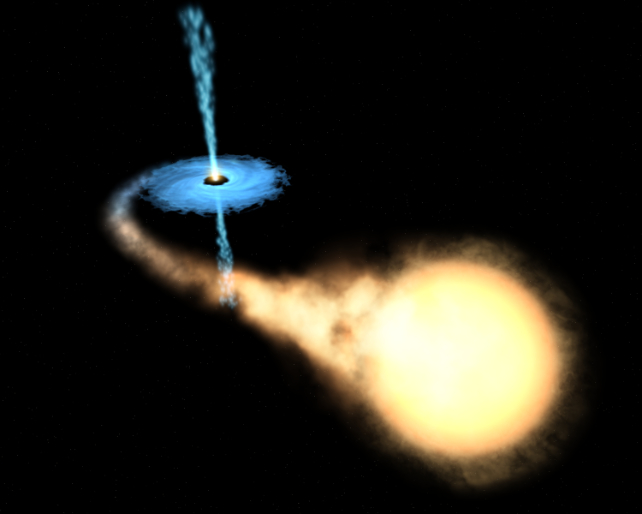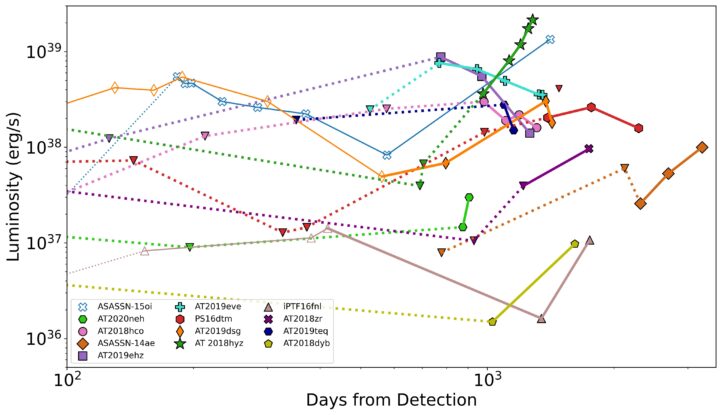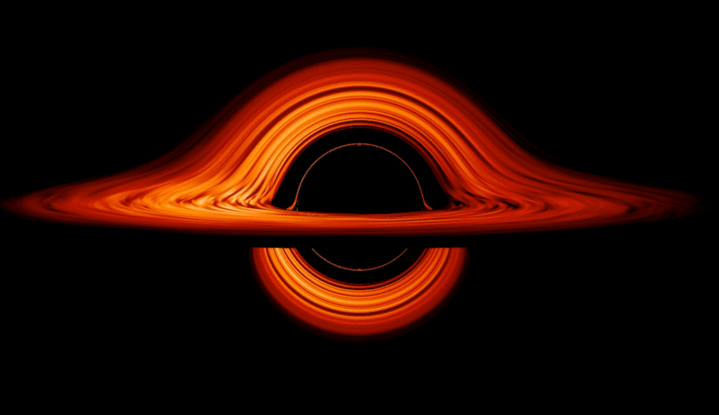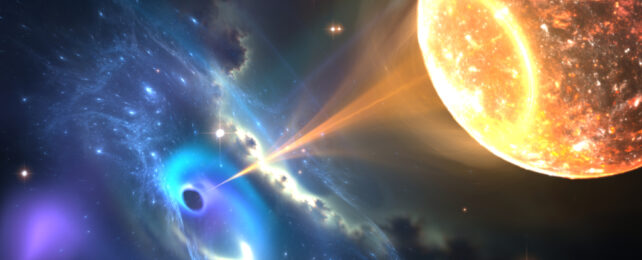For a few hours after a star smashes into a supermassive black hole, some of the brightest light in the Universe is produced.
The subsequent flash of radio waves were thought to simmer down within weeks or months of a collision. It turns out we might have been a little impatient to turn our gaze elsewhere.
An international team of astrophysicists has witnessed radio waves bursting from material surrounding an assortment of supermassive black holes hundreds of days after they ripped apart a star, suggesting many collisions could be responsible for a serious case of cosmic indigestion.
"Up to half of all black holes that shred a star 'burp' material years after the initial event," says astrophysicist and lead author Yvette Cendes. "No one was expecting this, and we don't really understand why this might be!"
Using observations from three radio telescopes – the Very Large Array in the United States, MeerKAT in South Africa, and the Australian Telescope Compact Array – the team collected long-term data on 24 black holes.
Of those two dozen guzzling behemoths, ten sat quietly for around 500 to 2,000 after enjoying its stellar lunch only to belch out a blast of radio waves.
Their findings are yet to be peer reviewed, but are currently available on the pre-print server arxiv.org for anybody to dig through.
When a star comes too close to a black hole, the immense gravitational pull elongates it into a spaghetti shape. Within hours, the star is torn to shreds in what is called a 'tidal disruption event'. This produces one of the brightest optical flares in the Universe.

About 20 to 30 percent of these tidal disruption events will produce an outflow of radio waves in the early stages. Only around 100 of these tidal disruption events have been seen since the first was recorded in the 1990s.
Once this bright light has been observed, researchers usually "move on to other things" as "radio telescope time is precious" , Cendes explains in a thread on Reddit. "Like, why go to the site of an explosion years after the fact?"
A discovery made last year seemed to turn this logic on its head. Cendes and her team found that a black hole 20 million times more massive than the Sun was emitting jets of radio waves around three years after shredding a star, which was "absolutely wild," says Cendes.
The team nicknamed this black hole Jetty McJetface, or 'Jetty' for short.
"Jetty was just one of 24 tidal disruption events we were studying… What the heck were the rest of them doing?!" says Cendes.

Contrary to popular belief, black holes don't suck stars in like a vacuum cleaner. They consume stars much like the Cookie Monster eats cookies: by creating a mess.
Very little of the stellar material crashing into a black hole actually passes the event horizon (beyond which the gravitational pull is so great that no even light can escape).
Around half of the stellar material gets ejected outwards into the galaxy and the other half joins the debris orbiting the black hole, called the accretion disc.

There are two possible reasons why the remnants of stars swirling around black holes might start emitting radio waves years after a collision, the authors write.
One possibility is that it takes considerable time for the debris circling the black hole to settle into a stable orbit.
An alternative is that the debris is weakly bound to the supermassive black hole and forms a sphere envelope, which "must cool and radically contract to form an accretion disk", the authors write.

"If accretion onto the supermassive black hole supplies energy to the envelope… full contraction of the envelope can be delayed for a time, up to ∼700 days, in agreement with the time scales of the outflows measured in this work.
"Thus, we see that disk formation can be delayed for hundreds to thousands of days, providing an alternative explanation for late-onset radio-generating outflows from the supermassive black hole."
This paper appeared as a preprint on arXiv.org.
